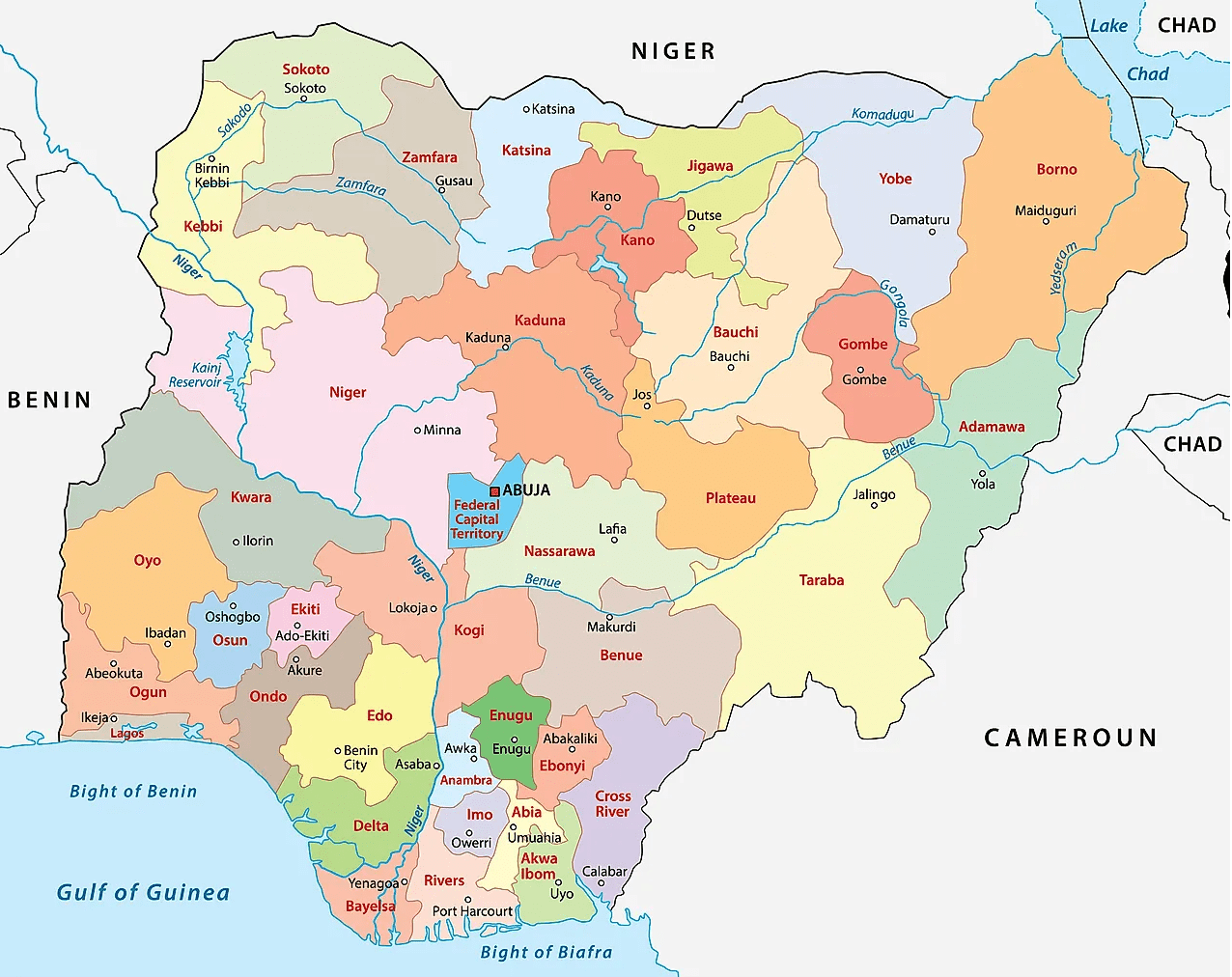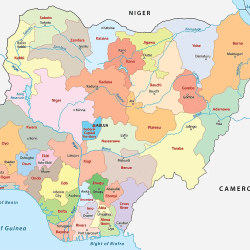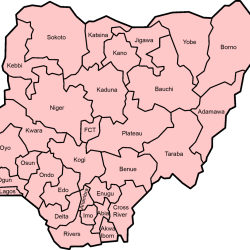The states and capitals of the Federal Republic of Nigeria are:
| SN | State | Capital |
| 1 | Abia | Umuahia |
| 2 | Adamawa | Yola |
| 3 | Akwa Ibom | Uyo |
| 4 | Anambra | Awka |
| 5 | Bauchi | Bauchi |
| 6 | Bayelsa | Yenagoa |
| 7 | Benue | Makurdi |
| 8 | Borno | Maiduguri |
| 9 | Cross River | Calabar |
| 10 | Delta | Asaba |
| 11 | Ebonyi | Abakaliki |
| 12 | Edo | Benin City |
| 13 | Ekiti | Ado-Ekiti |
| 14 | Enugu | Enugu |
| 15 | Gombe | Gombe |
| 16 | Imo | Owerri |
| 17 | Jigawa | Dutse |
| 18 | Kaduna | Kaduna |
| 19 | Kano | Kano |
| 20 | Katsina | Katsina |
| 21 | Kebbi | Birnin Kebbi |
| 22 | Kogi | Lokoja |
| 23 | Kwara | Ilorin |
| 24 | Lagos | Ikeja |
| 25 | Nasarawa | Lafia |
| 26 | Niger | Minna |
| 27 | Ogun | Abeokuta |
| 28 | Ondo | Akure |
| 29 | Osun | Oshogbo |
| 30 | Oyo | Ibadan |
| 31 | Plateau | Jos |
| 32 | Rivers | Port Harcourt |
| 33 | Sokoto | Sokoto |
| 34 | Taraba | Jalingo |
| 35 | Yobe | Damaturu |
| 36 | Zamfara | Gusau |
| Federal territory (similar to a state) | Capital |
| Federal Capital Territory (FCT) | Abuja |
List of Nigeria’s 36 states & Abuja
- Abia
- Adamawa
- Akwa Ibom
- Anambra
- Bauchi
- Bayelsa
- Benue
- Borno
- Cross River
- Delta
- Ebonyi
- Edo
- Ekiti
- Enugu
- Gombe
- Imo
- Jigawa
- Kaduna
- Kano
- Katsina
- Kebbi
- Kogi
- Kwara
- Lagos
- Nasarawa
- Niger
- Ogun
- Ondo
- Osun
- Oyo
- Plateau
- Rivers
- Sokoto
- Taraba
- Yobe
- Zamfara
Federal Capital Territory, Abuja
Maps of Nigeria’s 36 states & Abuja

States creation, reformation
By the time Nigeria got independence the country was a federation of three regions, namely:
Western
Eastern
Northern
Later on another region was added, the Mid-Western Region.
The Mid-Western Region was formed from the Western Region in 1966, and Lagos, the capital, was effectively governed as an unofficial fourth region outside the bounds of the Western Region.
This brought the number of regions to 4 as follows:
Western
Mid-Western
Western
Northern
Under the short-lived military government of Aguiyi-Ironsi, Nigeria was reorganized under a central government. Following a coup which resulted in Aguiyi-Ironsi’s deposition and assassination, Nigeria was reorganized as a federal country again with three of the regions being divided into newer entities and all first-level subdivisions being renamed as states.
Western Region was divided into:
Lagos
and Western states.
Eastern Region was divided into:
East-Central,
Rivers
and South-Eastern states;
Northern Region was divided into:
Benue-Plateau,
Kano,
Kwara,
North-Central,
North-Eastern
and North-Western (Sokoto) states
1976 reformation of Nigeria’s federating units
In 1976, six years after the end of the civil war, the states were further reorganized:
State boundaries and names were also reorganized.
Benue-Plateau state divided into:
Benue
and Plateau states.
East-Central state divided into:
Anambra
and Imo states.
Federal Capital Territory (Abuja) was formed from parts of Niger and Plateau states.
North-Eastern state divided into:
Bauchi,
Borno,
and Gongola states.
Niger (Minna) state split from Sokoto.
Western state divided into:
Ogun,
Ondo
and Oyo states
States of Nigeria from 1987-1991
Akwa Ibom state created from Cross River;
Katsina state created from Kaduna
States of Nigeria from 1991-1996
Abia State created from Imo;
Bendel State divided into Delta and Edo;
Enugu State created from Anambra;
Gongola State divided into Adamawa and Taraba;
Jigawa State created from Kano;
Kebbi State created from Sokoto;
Kogi State formed from parts of Benue and Kwara;
Osun State created from Oyo;
Yobe State created from Borno.
States of Nigeria from 1996
Bayelsa State created from Rivers;
Ebonyi State was formed from parts of Abia and Enugu;
Ekiti State created from Ondo;
Gombe State created from Bauchi;
Nasarawa State created from Plateau;
Zamfara State was created from Sokoto.
More on Nigeria
Nigeria is a country in Africa, a regional power on the continent and an emerging power on the international scene.
It has 36 states and a Federal Capital Territory, Abuja.
Having being divided into states, the country is further divided into 774 Local Government Areas (LGAs).
The LGAs are under the control of their respective states.
The country has the largest economy in Africa.
Nigeria’s population is over 230 million, making it number 1 most populated country in Africa, and number 6 in the world.

It covers an area of 923,769 square kilometres (356,669 sq mi).
It is situated between the Sahel to the north and the Gulf of Guinea to the south in the Atlantic Ocean.

Nigeria borders Niger in the north, Chad in the northeast, Cameroon in the east, and Benin in the west.
It is often referred to as the Giant of Africa owing to its large population and economy and is considered to be an emerging market by the World Bank.

However, the country ranks very low in the Human Development Index and remains one of the most corrupt nations in the world.

The largest city in Nigeria is Lagos, one of the largest metropolitan areas in the world and the largest in Africa.

Nigeria is a multinational state inhabited by more than 250 ethnic groups speaking 500 distinct languages, all identifying with a wide variety of cultures.

The official language is English, chosen to facilitate linguistic unity at the national level.
Nigeria is a founding member of AU (African Union) and a member of other international organizations including UN (United Nations), Commonwealth of Nations and ECOWAS (Economic Community of West African States).



